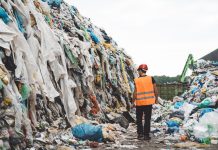A new report from the European Commission’s Joint Research Centre (JRC) reveals that adopting circular economy practice’s in heavy industry could cut up to 231 million tonnes of CO2 equivalent emissions per year by 2050
These reductions would come from key sectors such as steel, aluminium, cement, and concrete, as well as plastics. These industries currently account for nearly 15% of the EU’s total greenhouse gas emissions.
The findings suggest that integrating circularity into industrial production isn’t just an environmental imperative; it could also boost the EU’s energy resilience and economic security.
Most considerable emission reductions from steel and plastics
Among the sectors studied, steel and plastics have the highest potential for emission savings. The report estimates that circular economy practice’s could reduce annual emissions from the steel sector by 64 to 81 million tonnes of CO₂ equivalent. In comparison, the plastics sector could achieve a reduction of 75 to 84 million tonnes.
These savings would come from a combination of improved materials management, including reducing the use of virgin materials, increasing reuse and recycling, and enhancing product design for longevity and efficiency.
Less energy, fewer imports
The benefits of a circular economy extend beyond emissions. By using fewer raw materials and improving energy efficiency, the EU could lower its fossil fuel energy demand by nearly 4.7% compared to 2023 levels. Electricity consumption would also drop by a similar percentage.
This shift would reduce the EU’s reliance on imported fossil fuels and critical raw materials, boosting the region’s energy independence and resilience in the face of global market volatility. Importantly, this reduction in demand doesn’t require breakthroughs in technology—it can be achieved with existing tools and better material practices.
Boosting economic and trade security
Circularity doesn’t just save carbon, it also saves money. The JRC report estimates that circular economy practice’s could improve the EU’s trade balance by approximately 4%, or € 35 billion, by 2050. This gain would result from reduced imports of key raw materials, such as iron ore (down 22%) and bauxite (down 11%), as well as a decline in fossil fuel imports.
Plastics, in particular, stand out as a major contributor to these savings, thanks to the high volume of imported fossil fuels used in their production. By increasing recycling and using alternatives, the EU can decrease both costs and emissions.
Steps towards a circular future
To help accelerate the transition, the report outlines a set of policy recommendations aimed at both industry and government. These include investing in technologies to enhance the quality of recycled materials, designing products more efficiently to utilise fewer resources, and using tools like Green Public Procurement to influence market demand.
These measures align with recent EU initiatives, such as the Clean Industrial Deal and the EU Competitiveness Compass, both of which emphasise the importance of circular economy practice’s in establishing a more sustainable, competitive, and resilient industrial base.
With climate neutrality on the horizon for 2050, the findings of this report show the critical role the circular economy can play by creating a more robust and self-reliant European economy.











